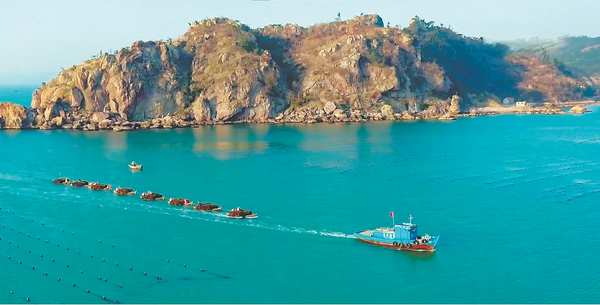

Diving into the subject
In the program, Xu Kuidong, a researcher at the Institute of Oceanology, Chinese Academy of Sciences, takes the audience on a journey through the marvelous history of marine life using the Hai Cuo Tu, China's earliest comprehensive encyclopedia of marine organisms.
"Even in this era of rapid technological advancement, only 5 percent of the ocean floor has been explored. Research suggests that there could be 1 million species in the ocean, yet we have only uncovered about a quarter of them," explains Xu.
The allure of the extraordinary marine creatures is simply irresistible. As a dedicated scientist, Xu is committed to venturing deeper into the ocean to explore its vibrant and diverse marine life, and he also looks forward to sharing more captivating tales of the wondrous ocean with everyone.
In another installment, Liu Feng, the overall commander of the Jiaolong manned submersible, shares the story behind the design of the ship.
The Jiaolong manned submersible, the research, development, and testing process of which he participated in, is China's first independently designed and integrated manned deep-sea submersible. It is world-leading and has broken records for the depths it can reach compared to similar operational manned submersibles.
With global media focused on such matters following recent tragic events, according to Liu, ensuring the safety of personnel was the foremost consideration during the design of the Jiaolong submersible. Due to the immense pressure the submersible would be subjected to, a spherical three-dimensional structure, known for its stability, was chosen.
"The manned sphere, in particular, has a thick wall that couldn't be formed through a single stamping process. Instead, we welded together 12 watermelon-shaped segments to create two hemispheres, which were then joined to form a complete sphere," he says.
"We also incorporated three observation windows and an access hatch for personnel. With the presence of multiple openings in the sphere, the precision and requirements for its production were incredibly high," Liu explains.
Liu believes that the greatest accomplishment of the Jiaolong's development is not the submersible itself, but rather the growth of scientists throughout the process, which has provided a solid foundation for further deep-sea exploration.
One highlight of the show is that it utilizes augmented reality and extended reality to provide interactive on-site experiences, with the aim of popularizing science among the general public.
Over the course of the program, the stage design undergoes multiple changes, encompassing elements such as submarines, aquariums, and artistic representations of ocean waves.
Leveraging XR technology, the grandeur of the ocean world is seamlessly integrated into the stage, resulting in an immersive audiovisual experience for the audience.
When Tang Limei, the first female scientist in China to dive aboard the Jiaolong manned submersible, shared her story, the screen behind her transformed into a deep-sea sightseeing elevator.
"During the time spent aboard the Jiaolong, I witnessed the most unforgettable and mesmerizing deep-sea scenery. Planktonic organisms swarmed like snowflakes in the vast expanse, while bioluminescent creatures illuminated the dim abyss with their radiant glow," Tang recalls.
From the perspective of the elevator, the audience is taken on a journey, plunging deep toward the seabed, getting to know the underwater world.
"As we descended to a depth of 1,000 meters, we encountered a group of enchanting creatures. To adapt to the darkness they inhabit, they have evolved the ability to emit their own light," Tang says.
"Among them, the bioluminescent properties of the glass octopus stood out. Its transparent body allowed us to see its internal organs clearly, making it the brightest star of the deep sea."
Tang was thrilled when she saw the AR scenes during the recording. "I didn't expect that the scenes presented in the design plan would come to life like that," she says.